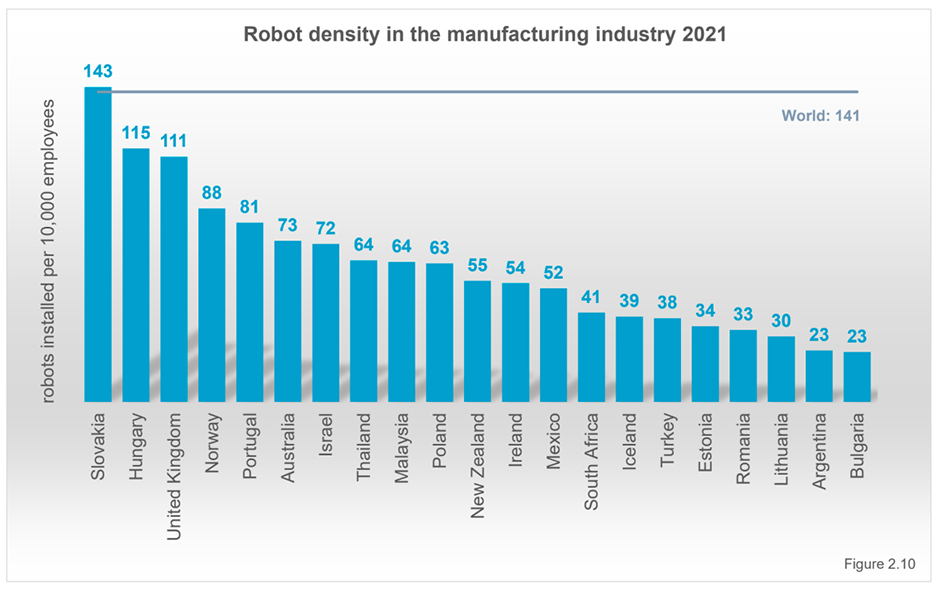By Tom Bouchier, Managing Director, FANUC UK
The UK has a strong and proud manufacturing history and, for a small nation, has long punched above its weight on the global stage. Today, the UK remains the ninth largest manufacturing nation in the world, with a £183bn output[1]. But our seat at the top table is looking precarious as a result of our slow adoption of industrial automation. No longer the preserve of Asian powerhouses like China, Japan or the Republic of Korea, the recently published IFR World Robotics Industrial Robots 2022 report reveals that countries far closer to home such as Slovenia, Slovakia, Finland and Hungary are now outpacing the UK when it comes the adoption of robotics. If we are to continue competing on the global stage, it is imperative that the UK’s automation community comes together to support British firms to embrace robotics and ensure our reputation as a nation of manufacturers continues to thrive.
A record-breaking year
As acknowledged in its foreword, the statistics contained in the 2022 IFR report are a strong indication of the vital contribution that robotics is making towards supporting businesses to protect their core production processes against the effects of the numerous global crises that we have experienced over the past few years. A record 517,385 new robots were installed in 2021 – an impressive 31% uplift from 2020. As well as traditional automation adopters such as the automotive, electronics, and metal & machinery industries, advances in robotic capability through digitalisation and AI have seen sectors such as warehousing and logistics also begin deploying automated solutions.
UK bucks the global trend
Robotics has a key role to play in enabling manufacturers from all countries to remain agile, cost efficient and globally competitive, and the fact that 2021 saw the highest number of new robot installations on record is particularly encouraging. But, from a UK perspective, the IFR results were more sobering. At 2,054, the number of new robot installations was down 7% year-on-year, giving the UK an average manufacturing robot density of 111 robots for every 10,000 employees, which the report notes is ‘very low for a Western European country’. This figure is well below the global average of 141 and considerably under the top performing nation of the Republic of Korea (1,000) and the European frontrunner, Germany (397). In fact, the UK is currently languishing at 24th in the world robot density rankings, making us the only G7 country to sit outside the top 20.


Boosting productivity
The UK’s position as a leading manufacturing nation is unquestionable; but we could increase our productivity levels significantly if we used more automation. To put it into context, many countries have a manufacturing industry that accounts for a similar 10% GDP as the UK (the USA, the Netherlands, Denmark and Sweden, for example); but their productivity rates are higher than ours as a result of their greater investment in automation. Astonishingly, a German worker is around 30% an hour more productive than a UK worker – put simply, we cannot expect to continue competing on the international stage unless we automate.
Labour crisis
The need to automate has become even more imperative in the last few years in the face of a series of unprecedented global and national crises, which have impacted UK manufacturers’ ability to recruit staff. Already facing a labour shortfall, a perfect storm of Brexit and the Covid pandemic prompted an exodus of European labour from our shores, contributing to the 97,000 vacancies in the manufacturing sector reported in January 2022 (a year-on-year increase of 113%)[2]. As well as this ‘cost of leaving’ crisis, the country is also facing a cost of living crisis, which has seen manufacturers grapple with rising bills for energy, transport and raw materials.
Recruiting hard-to-find manual labour while managing increasing costs is a difficult balancing act, but it can be alleviated through automation. By using robots to do the dull, dirty and dangerous tasks, automation enables manufacturers to make better use of their human employees, upskilling them to boost recruitment and retention rates while increasing productivity.
A bright future
The outlook, therefore, is brighter than it may currently appear. In 2015, robot density in the UK was just 71 robots per 10,000 employees – the current figure of 111 demonstrates a 56% increase, and this is reflected here at FANUC UK in our healthy order book going into 2023.
The UK already boasts world class engineers, world class machine tool builders, world class integrators and a world class workforce. To retain our reputation as a nation of world class manufacturers, we now need to support firms to implement world class automation technology.







